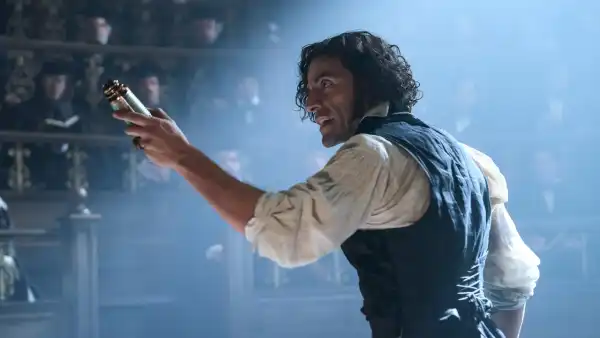
Save this storySave this storySave this storySave this story
Previously this year, Quentin Tarantino, when probed about the highlights of his body of work in an interview, characterized the two-part “Kill Bill” (2003-04) as “the picture I was destined to create.” He continued, “I consider ‘Inglourious Basterds’ my apex, yet ‘Once Upon a Time . . . in Hollywood’ is my preferred.” Could these be distinctions lacking actual contrast? I’m typically skeptical of origin-story narratives for artists, largely due to the fact that a filmmaker possessing notable talent, consistent vision, and fortunate circumstances could easily accrue numerous contenders for such distinction. Take Ryan Coogler, who has attached the “destined to create” sentiment to both his initial feature, “Fruitvale Station” (2013), and his most recent, “Sinners” (2025)—his only two films, it bears mentioning, that aren’t entries in a studio-owned series.
However, regarding the fresh “Frankenstein,” which represents the thirteenth picture helmed by Guillermo del Toro—and is, by nearly every account, the film he was destined to produce—the cliché merits further deliberation before being swiftly disregarded. This is del Toro’s highly personal quest within cinema, one that he has been pursuing, if not since birth, then certainly from the instant he first became captivated by James Whale’s seminal “Frankenstein,” from 1931. Back then, del Toro was seven years of age, growing up in Guadalajara, Mexico. At eleven, he perused Mary Shelley’s 1818 novel, “Frankenstein; or, the Modern Prometheus.” His films, which have elevated him to Hollywood’s premier contemporary horror-fantasy artist, are permeated with Frankensteinian motivations. No director is more devoted to the humanness of the monster and the monstrousness of humanity. In “The Shape of Water” (2017), we champion a scaled amphibious mutant and applaud his oppressor’s downfall. In “Nightmare Alley” (2021), which situates us among the deformed inhabitants of a travelling carnival, a striking, charming seducer is the only genuine oddity to behold. The magnificent “Pan’s Labyrinth” (2006)—speaking of a film that del Toro was meant to make—pays homage to one of the most subtly Frankenstein-esque films, Victor Eríce’s “The Spirit of the Beehive” (1973). Within that radiant classic, a six-year-old girl, after viewing the 1931 film, perceives the monster as utterly, terrifyingly tangible. She and the young Guillermo, who became nine the year Eríce’s film debuted, shared a strong connection.
Nevertheless, del Toro has done more than simply fashion another Whale-esque narrative. For one thing, his “Frankenstein,” currently showing in select cinemas and initiating streaming on November 7th, via Netflix, spans two hours and twenty-nine minutes—ample time to watch the 1931 film twice, with a popcorn break in between. For another, the Creature is portrayed by Jacob Elordi, who, like a majority of performers who have believably embodied Elvis Presley, doesn’t quite mirror Boris Karloff in his era. The Creature, so frequently presented as a disgruntled green giant, is now an enthralling exploration of conscious marble—a towering, supple, ivory-hued being, his head bare (initially), his face and physique adorned with regions of somber blue, and his loins, while presumably as reanimated as the remainder of him, are discreetly concealed.
The first instance we come across the Creature, though, we barely catch a glimpse of him at all: he manifests as a featureless phantom, encased in a shadowy cloak and possessed by a vindictive disposition, relentlessly pursuing his originator, Baron Victor Frankenstein (Oscar Isaac). The year is 1857, and we find ourselves somewhere within the Arctic. A vessel, en route to the North Pole, is ensnared in ice, and its marooned crew, captained by Captain Anderson (Lars Mikkelsen), extend refuge to Victor, who is severely injured. A significant portion of this originates from the novel, although Shelley must have excluded the detail where the Creature slays several sailors with his exposed hands and gets blasted off the side of the ship, apparently meeting his demise. Yet, in a quintessential del Toro flourish, the Creature’s skeletal digits perform a spidery tap dance amidst the snow—a signal that he is poised to propel himself back into the conflict. In a clever homage to Whale, someone shouts, “It lives!”
Through a surge of ingenuity, the Creature is momentarily restrained, affording the weakened Victor adequate time to entertain the esteemed Captain with his life story. In an extensive flashback, we are introduced to the young Victor (Christian Convery), a perceptive, dark-haired child born into considerable privilege but also subjected to brutal paternal mistreatment. His father, Baron Leopold Frankenstein (Charles Dance, disturbingly reptilian as always), is a surgeon; he ingrains his medical expertise into his son and delivers a forceful smack when verbal instruction proves insufficient. Victor shares a much closer bond with his mother, Claire (Mia Goth), a quietly nurturing soul, albeit fleetingly. She passes away during the birth of a second son, William, and for Victor, tragedy metamorphoses into purpose: he commits to overcoming death, and surpassing his father’s legacy, by mastering the creation of new life. The tender Convery seamlessly transitions into Isaac, who assumes the role with the fervent gaze of a man consumed.
One of the narrative’s most poignant ironies is that Victor will evolve into a more stringent, more inattentive, and vastly more destructive paternal figure than Leopold ever was. Del Toro, perpetually attuned to the intricacies of procedure, transforms the sinewy mechanics of reanimation into a series of referendums on Victor’s essence. When he nonchalantly selects his path through recently deceased corpses on a battlefield, Victor exhibits more than mere scientific impartiality; subsequently, one almost anticipates him to hum a tune as he works, sawing through a cadaver’s limb. Meaning is found in the specifics, and del Toro derives considerable delight from them; much like Victor, he is a connoisseur of bloodshed. Ample scholarly consideration is also devoted to the science of electrical storage, enabling a body to operate as a perpetually recharged battery, and to the utilization of a colossal lightning-rod apparatus, which will harness lightning from the summit of a secluded tower, where Victor conducts his experiments. (The strikingly angular production design, by Tamara Deverell, manifests a pronounced inclination towards turret-like structures.) Upon the Creature’s astonishing revival, although not precisely as envisioned, Victor is captivated for merely about five minutes before seemingly losing interest. He perceives only the imperfections—and not the peculiar, unforeseen marvels—within his creation.
Should you overlook the sensation of familial history brutally replicating itself, here is Mia Goth once more, this time embodying Elizabeth, the betrothed of Victor’s younger brother, William (Felix Kammerer). When Victor develops affections for her, it serves as the film’s subtle method of emphasizing his mother-fixation—an Oedipal undertone validated by the exquisite costumes fashioned by Kate Hawley, who dresses both Claire and Elizabeth in gowns of striking color and plumage. Following Victor’s confinement of the Creature beneath the stairs, it is Elizabeth who uncovers and befriends him, even as her revulsion towards Victor escalates correspondingly. Few filmmakers who witnessed Goth’s menacing presence amidst the devastation of “Pearl” (2022) and “Infinity Pool” (2023) would contemplate casting her as a woman of virtue. However, del Toro is engaging in an intricate, genre-defying game; he employs the visual lexicon of horror—a format that Goth personifies—to propel us beyond horror’s anticipations.
Throughout the film, del Toro wavers and lingers between antithetical notions, with the restless nature of the exquisite butterflies that Elizabeth, an amateur entomologist, enjoys studying. Aspiring to liberate the Frankenstein myth from the enervating confines of parody and imitation, del Toro revisits Shelley’s novel with renewed reverence, although few would misinterpret him as a literary traditionalist. His innovations emerge from within the source material, but also from within himself; it’s as though he’s merged with the text so intimately that the deeper he delves, the more intensely personal his deviations and embellishments become. An image of an angel recurs, radiant in red, who haunts Victor’s childhood reveries. A Catholic depiction brought to fervent life, she embodies a quintessential del Toro image, reminiscent of the winged seraphim in “Cronos” (1992) and “Hellboy II: The Golden Army” (2008).
Subsequently, Victor will forfeit one of his legs in a terrifying blaze—a progression of events so engrossing that even del Toro’s most dedicated enthusiasts might overlook the visual and narrative allusions to “The Devil’s Backbone,” his ethereal war drama from 2001. Numerous films, numerous monsters: if virtually all of del Toro’s endeavors have been progressing towards “Frankenstein,” it stands to reason that “Frankenstein” should embody echoes of nearly all his endeavors.
“What qualifies a person as human?” a character ponders in the conclusive scene of “Hellboy,” del Toro’s comic-book adaptation from 2004. “Is it their origins, the manner in which they come into existence? I think not. It’s the decisions they enact—not how they commence things but how they resolve them.” These pronouncements could, naturally, depict Victor Frankenstein and his Creature, and the collective enchantment of del Toro’s film lies in his ability to evoke our profound empathy for both. Within the film’s latter segment, the Creature recounts his rendition of occurrences, which shifts between gentleness and ferocity, and ultimately becomes heartbreaking. Set adrift in a frigid wilderness—a poignant yet welcome departure, visually, from the Gothic shadows of Victor’s dwelling—the Creature encounters a hint of compassion, bestowed by a blind elderly farmer (a marvelous David Bradley), but also a surge of anguish, courtesy of everyone else. He acquires the skills of reading and speech, and, in a detail drawn directly from Shelley, becomes engrossed in the eschatological puzzles of “Paradise Lost.” He also deduces that the world operates on violence, something that—possessing extraordinary strength, self-healing capabilities, and unsolicited immortality—he is uniquely positioned to administer.
Del Toro’s empathy for the Creature is absolute—and consequently, as a result of the piercing sorrow and intrinsic fury of Elordi’s portrayal, so is ours. However, the director’s identification, notably, lies almost exclusively with Victor, and his admiration for this tormented manipulator carries a confessional undertone. Both individuals are resolutely detail-oriented artisans, dedicated to pushing existing technologies to their extremes and beyond—a feat that they cannot realize in isolation. One pivotal character I have yet to mention is Henrich Harlander (Christoph Waltz), an arms dealer who, for obscure motivations of his own, insists on funding Victor’s implausible scheme, thereby effectively labeling this “Frankenstein” as an allegory of tech-bro arrogance and A.I. dystopia. In her review of the film for the Los Angeles Times, critic Amy Nicholson playfully equated Harlander to “venture capitalists such as Bryan Johnson and Peter Thiel who’ve been exploring the potential of infusing their veins with young blood.”
My personal interpretation guided me along a more constricted and possibly less terrifying avenue, yet one containing cautionary implications of its own. Harlander, a wealthy benefactor with a penchant for upheaval, strikes me as an effective proxy for Netflix. And, analogous to Victor’s Harlander-funded experiment going awry logistically, so too does del Toro’s Netflix-backed passion project feel, despite all its aesthetic qualities and intricacies, akin to a technologically compromised creation. This “Frankenstein” presents a visual feast, though not, as portrayed here, an exceptionally rich or extravagant one. When experienced on the expansive screen, it functions as both a spectacle and a puzzle. You register the remarkable precision of del Toro’s visual concepts, yet the images themselves convey an uninspiring, strangely digitized flatness, lacking the immersive texture or atmosphere that the cinematographer, Dan Laustsen, achieved in “The Shape of Water” and “Nightmare Alley,” and exhibiting an excess of strikingly apparent visual effects.
“Frankenstein” thus represents an immense, remarkably elaborate canvas that paradoxically feels optimized for the smaller screen, and, attributable to its limited theatrical distribution strategy, a small-screen encounter is what it will predominantly remain. For those among us who encountered our most chilling monsters in the darkness of a cinema, this constitutes a form of injustice in itself, yet an injustice that the industry has gradually normalized. Del Toro may indeed have been destined to create this film, yet I’m less certain he was destined to create it for Netflix, which, for all its concerted courting of renowned auteurs, has yet to satisfactorily address (or even exhibit any interest in addressing) a fundamental inquiry: What characterizes a film as a film? ♦
Sourse: newyorker.com






